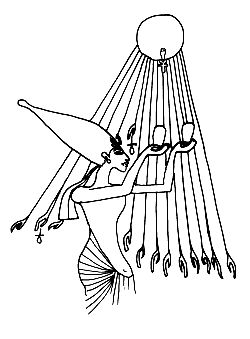
Designation of the sun disk as a celestial body, already in use in the Middle Kingdom. By the early New Kingdom the Aten had become a popular expression and was quickly personified. By the early 18th Dynasty the word was being written with a divine determinative. The breakthrough for the Aten occurred under Amenhotep IV / Akhenaten, who worshipped the god as the only god and challenged the existence of other gods. In his view the Aten was the king, as demonstrated by the fact that he wrote the name of the god in two cartouches. The full name of the Aten, adapted a number of times during the reign of Amenhotep IV, is almost a dogmatic announcement of the god's being. The name the Aten was given at the accession of Amenhotep IV was 'May Re-Harakhty who rejoices in the horizon in his name of Shu, who is the Aten, live'. In later versions of the name the names of other gods vanish. Originally, the god was depicted as a human with the head of a falcon and a sun's disk with uraeus snake. From about year two of the king, however, only the sun's disk itself was still depicted, with numerous sunbeams each ending in a hand. Sometimes, some of these hands hold ankh signs to the noses of the king and members of his family. Prayers and hymns to the Aten have come down to us in the tombs at El-`Amarna. There they replaced the usual funerary texts. The best known is the so-called Great Hymn to the Aten, apparently written by the king himself, among other places inscribed in the tomb of Ay at Akhetaten. The hymn praises the glory of the Aten, as apparent from the beauty of his creation. Although the motifs were not new, they were now used without any mythological allusions. It has been demonstrated that the text of the hymn has much in common with Psalm 104 from the Bible. After the death of Akhenaten and the abandonment of Akhetaten, the temples to the Aten were dismantled and the stones used as building material in other temples.